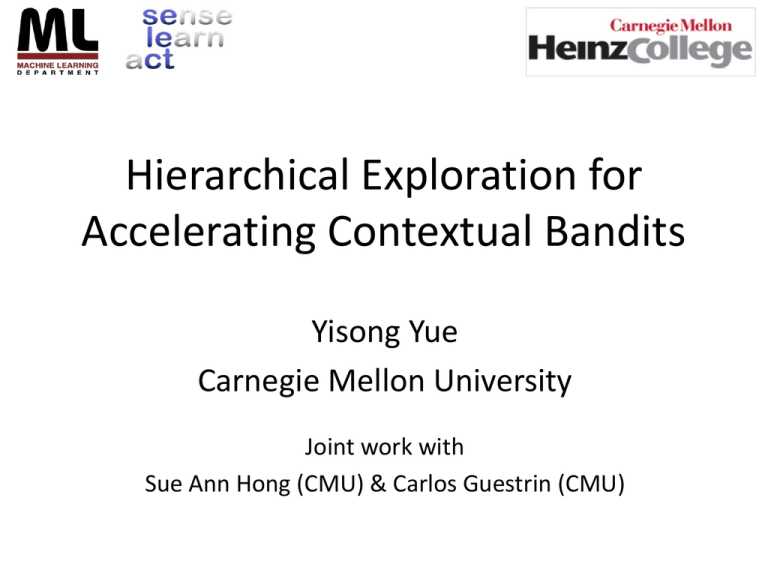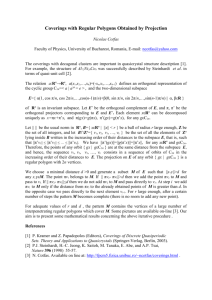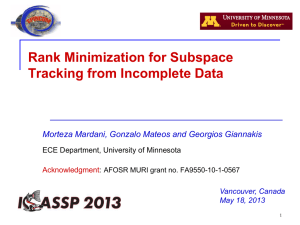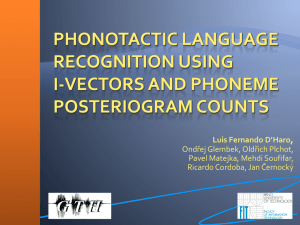talk - Carnegie Mellon University
advertisement

Hierarchical Exploration for
Accelerating Contextual Bandits
Yisong Yue
Carnegie Mellon University
Joint work with
Sue Ann Hong (CMU) & Carlos Guestrin (CMU)
Sports
…
Topic
# Likes
# Displayed
Average
Sports
1
1
1
Politics
0
0
N/A
Economy
0
0
N/A
Politics
…
Topic
# Likes
# Displayed
Average
Sports
1
1
1
Politics
0
1
0
Economy
0
0
N/A
Economy
…
Topic
# Likes
# Displayed
Average
Sports
1
1
1
Politics
0
1
0
Economy
1
1
1
Sports
…
Topic
# Likes
# Displayed
Average
Sports
1
2
0.5
Politics
0
1
0
Economy
1
1
1
Politics
…
Topic
# Likes
# Displayed
Average
Sports
1
2
0.5
Politics
0
2
0
Economy
1
1
1
Politics
Exploration / Exploitation Tradeoff!
• Learning “on-the-fly”
• Modeled as a contextual bandit problem
• Exploration is expensive
• Our Goal: use prior knowledge to reduce exploration
…
Topic
# Likes
# Displayed
Average
Sports
1
2
0.5
Politics
0
2
0
Economy
1
1
1
Linear Stochastic Bandit Problem
• At time t
– Set of available actions At = {at,1, …, at,n}
• (articles to recommend)
– Algorithm chooses action ât from At
• (recommends an article)
– User provides stochastic feedback ŷt
• (user clicks on or “likes” the article)
• E[ŷt] = w*Tât (w* is unknown)
– Algorithm incorporates feedback
– t=t+1
Regret:
R(T ) = å w*T at* - w*T aˆt
t
Balancing Exploration vs. Exploitation
“Upper Confidence Bound”
• At each iteration: argmax w a + Ct (a)
aÎAt
T
t
Estimated Gain
Uncertainty
• Example below: select article on economy
Estimated Gain by Topic
+
Uncertainty of Estimate
Conventional Bandit Approach
• LinUCB algorithm
[Dani et al. 2008; Rusmevichientong & Tsitsiklis 2008; Abbasi-Yadkori et al. 2011]
– Uses particular way of defining uncertainty
– Achieves regret:
(
R(T ) = O w D T
*
)
• Linear in dimensionality D
• Linear in norm of w*
How can we do better?
R(T ) = å w a - w aˆt
*T
t
*
t
*T
More Efficient Bandit Learning
• Assume
LinUCB naively
w* mostly
explores
in subspace
D-dimensional
space
w*
– SDimensionality
= |w*|
K << D
– E.g., “European vs Asia News”
– Estimated using prior knowledge
• E.g., existing user profiles
• Two tiered exploration
– First in subspace
– Then in full space
(
R(T ) = O ( S^ D + Sp K ) T
Feature
Hierarchy
• Significantly less exploration
w*
LinUCB Guarantee:
(
R(T ) = O SD T
)
)
CoFineUCB: Coarse-to-Fine Hierarchical Exploration
At time t:
Least squares in subspace
Least squares in full space
(regularized to w )
wt
wt
wt
wt
t
Recommend article a that maximizes
aˆt = argmax wtT a + a t aT M t-1a
Uncertainty in
Full Space
+ a t a M UM U M a
Uncertainty in
Subspace
aÎAt
T
Receive feedback ŷt
-1
t
-1
t
T
-1
t
(Projection onto subspace)
(
R(T ) = O ( S^ D + Sp K ) T
)
Theoretical Intuition
• Regret analysis of UCB algorithms requires 2 things
– Rigorous confidence region of the true w*
– Shrinkage rate of confidence region size
• CoFineUCB uses tighter confidence regions
– Can prove lies mostly in K-dim subspace
– Convolution of K-dim ellipse with small D-dim ellipse
(
R(T ) = O ( S^ D + Sp K ) T
)
Constructing Feature Hierarchies
(One Simple Approach)
• Empirical sample learned user preferences
– W = [w1,…,wN]
LearnU(W,K):
• [A,Σ,B] = SVD(W)
• (I.e., W = AΣBT)
• Return U = (AΣ1/2)(1:K) / C
“Normalizing
Constant”
• Approximately minimizes norms in regret bound
• Similar to approaches for multi-task structure learning
– [Argyriou et al. 2007; Zhang & Yeung 2010]
Simulation Comparison
• Leave-one-out validation using existing user profiles
– From previous personalization study [Yue & Guestrin 2011]
• Methods
– Naïve (LinUCB) (regularize to mean of existing users)
– Reshaped Full Space (LinUCB using LearnU(W,D))
– Subspace (LinUCB using LearnU(W,K))
• Often what people resort to in practice
– CoFineUCB
• Combines reshaped full space and subspace approaches
(D=100, K = 5)
Naïve Baselines
Reshaped Full space
“Atypical Users”
Coarse-to-Fine Approach
Subspace
User Study
• 10 days
• 10 articles per day
– From thousands of
articles for that day
(from Spinn3r – Jan/Feb 2012)
– Submodular bandit
extension to model
utility of multiple articles
[Yue & Guestrin 2011]
• 100 topics
– 5 dimensional subspace
• Users rate articles
• Count #likes
Coarse-to-Fine
Wins
Coarse-to-Fine
Wins
~27 users per study
User Study
Ties
Losses
Naïve LinUCB
Losses
LinUCB with
Reshaped Full Space
*Short time horizon (T=10) made comparison with Subspace LinUCB not meaningful
Conclusions
• Coarse-to-Fine approach for saving exploration
– Principled approach for transferring prior knowledge
– Theoretical guarantees
• Depend on the quality of the constructed feature hierarchy
– Validated via simulations & live user study
• Future directions
– Multi-level feature hierarchies
– Learning feature hierarchy online
• Requires learning simultaneously from multiple users
– Knowledge transfer for sparse models in bandit setting
Research supported by ONR (PECASE) N000141010672, ONR YIP N00014-08-1-0752,
and by the Intel Science and Technology Center for Embedded Computing.
Extra Slides
Submodular Bandit Extension
• Algorithm recommends set of articles
• Features depend on articles above
– “Submodular basis features”
• User provides stochastic feedback
E[r(a) | A] = ( w
)
* T
D(a | A)
CoFine LSBGreedy
• At time t:
–
–
–
–
–
Least squares in subspace wt
Least squares in full space wt
(regularized to wt )
Start with At empty
For i=1,…,L
• Recommend article a that maximizes
a = argmax wtT D(a | At ) + a t D(a | At )T M t-1D(a | At )
a
+ a t D(a | At )T M t-1UM t-1U T M t-1D(a | At )
At = At È a
– Receive feedback yt,1,…,yt,L
Comparison with Sparse Linear Bandits
• Another possible assumption: w* is sparse
– At most B parameters are non-zero
– Sparse bandit algorithms achieve regret that depend on B:
• E.g., Carpentier & Munos 2011
• Limitations:
(
R(T ) = O SB T
)
– No transfer of prior knowledge
• E.g., don’t know WHICH parameters are non-zero.
– Typically K < B CoFineUCB achieves lower regret
• E.g., fast singular value decay
• S ≈ SP
(
R(T ) = O ( S^ D + Sp K ) T
)











